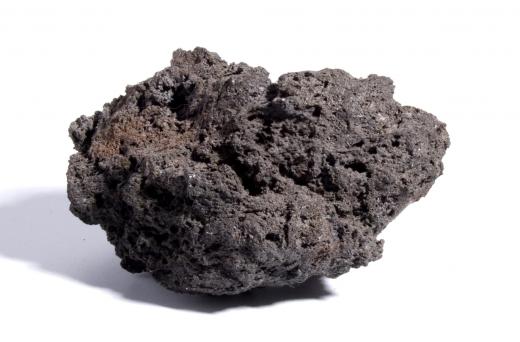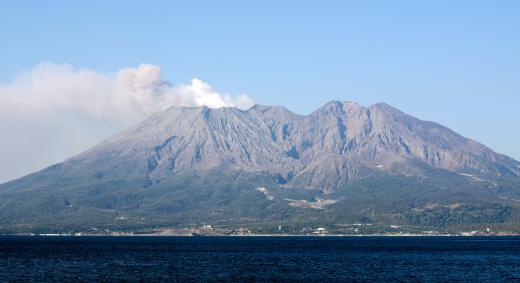What is a Large Igneous Province?
 Michael Anissimov
Michael Anissimov
A large igneous province is a region of the Earth's surface where a series of large eruptions over a geologically short time period (~1 million years) has resulted in a thick layer of volcanic rock covering the surface. Many scientists believe that large igneous provinces are caused by mantle plumes, where magma plumes from deep beneath the ground rise close to the surface, like the bubbles in a lava lamp. These are sometimes also called flood basalt events or flood basalt provinces, because most of the rock deposited is basalt.
When a mantle plume approaches the surface, the magma is under compression. Pressure builds up and volcanic eruptions occur. More than a million cubic kilometers of volcanic material may be released by a large igneous province. Some percentage of the material, usually between 5% and 20%, is released pyroclastically, that is, ejected into the air violently. The rest slowly oozes out of the large igneous province as lava. Often, large igneous provinces do not originate from a unified province, but rather multiple sub-provinces in the same general area. Certain large igneous provinces represent some of the geologically youngest areas of the continental surface, as most of the continents are composed of crust billions of years old known as shields.

Famous large igneous provinces include the Deccan Traps, a 2 km thick layer of igneous (volcanic in origin) rock covering 15% of modern India, and the Siberian Traps, of similar depth and extent. These areas are called "Traps" after the Swedish word for "stairs" (trappa, or sometimes trapp), because of the large stair-like basalt hills found throughout the formations. The Deccan Traps and Siberian Traps are associated with eruptions lasting less than a million years, occurring about 65 and 250 million years ago respectively.

The large igneous provinces of the Deccan and Siberian Traps coincided with two of the worst mass extinctions in the history of the planet, and the eruptions are thought to be main contributing causes. In the case of the mass extinction 250 million years ago, it is thought that lava from the Traps crept into the edges of the continental shelves of the oceans, releasing huge amounts of methane clathrate; methane gas trapped in cages of ice by microbes over the course of tens of millions of years. Methane is a greenhouse gas dozens of times more potent than carbon dioxide, and it is thought its mass release increased the global temperature, leading to a feedback process of further clathrate release and continued warming, eventually killing as much as 99.5% of the life in the oceans.
Luckily for us, the creation of large igneous provinces is rare. They only appear about once every 50 million years.
AS FEATURED ON:
AS FEATURED ON:












Discussion Comments
@Animandel -I know what you mean about how educational it can be to watch what goes on around active volcanoes. I was in Hawaii, and we took a helicopter ride over the lava fields, and we could actually see the lava flowing into the water and then hardening.
We actually saw the land pushing into the sea. This was remarkable to see the igneous metamorphic rock being formed. One moment you watching hot molten lava flowing into the sea, and then as the water cooled the lava the black rock appeared.
We also saw a lot of tuff, which is the rock formed by ash from the volcanoes when they erupt.
I think it would be interesting and educational to live in a place where there is still volcanic activity going on regularly. We think of the world being pretty much set in terms of the land we have available and then you think of places where volcanoes are erupting and forming new rocks and changing the earth's surface regularly. How cool must that be to see this happening?
I grew up watching the TV show Hawaii Five-0. And I have seen all of the vacation ads for the state of Hawaii where beaches, swimsuits, palm trees, and beautiful people are all over the place. On my first trip to Hawaii these were the images I had in mind when I stepped off of the plane.
However, after spending a couple weeks on the islands, my lasting impression of Hawaii has more to do with all of the volcanic rocks across the state. The igneous rock texture you find there is different from anything I experienced when I was growing up.
Post your comments